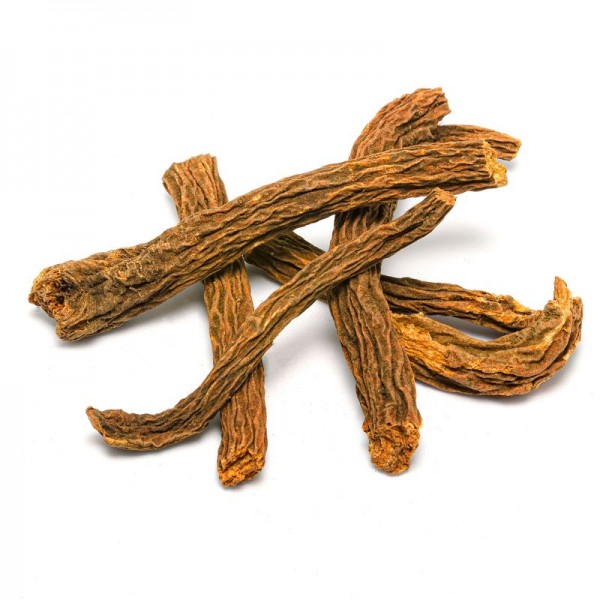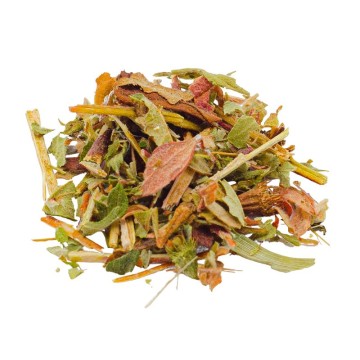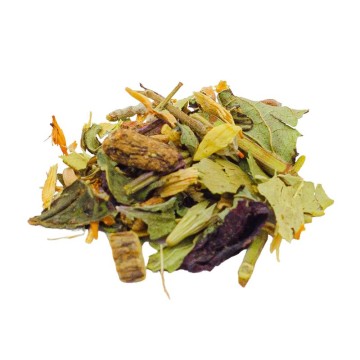The root of this plant is used and known, which contains active ingredients with eupeptic action , to promote digestion.
In addition, it has nutrients that make it a herbal resource with tonic and purifying properties. For these reasons, it has been used for centuries in medicine and in liqueurs throughout Europe.
Gentian: properties and benefits
The root of the gentian plant has a great wealth of elements that make its taste special, and features useful for our health.
Both the roots and the berries contain gentiopicrin, which causes the bitter taste of the liqueur and defines the medicinal properties of the plant.
gentiopicrin is a glucosidic compound (a sugar that joins the aglycone component), which in the past was used in medicine as an antimalarial substance; today it is appreciated for its properties that facilitate digestion and stimulate the appetite in gentian-based liqueurs and aperitifs.
Together with other minerals, gentiopicrin and other root substances give properties beneficial for the well-being of the liver (cholagogue), purifying and fighting inflammation during digestive transit. Gentian also has effective deworming properties.
In particular, the plant is known for its eupeptic characteristics, which stimulate the glandular cells of the digestive organs.
This tonic-stomachic plant is useful against heartburn and for the irritation of the esophagus - due to stomach acids - gentian root can be a contrast remedy . Also for the symptoms of acid reflux, gentian is one of the effective home remedies, to be combined with a healthy diet.
In addition, gentian roots can have an excellent impact in soothing digestive disorders such as gas formation, bloating, constipation, heaviness during digestion and other gastrointestinal problems. Consuming gentian roots can be useful, even to counteract lack of appetite.
Since gentian roots effectively stimulate the digestive system, it also makes it easier for the body to absorb some essential elements, such as iron.
A treatment with gentian roots is also useful for obtaining antioxidants, being rich in important minerals such as iron and zinc.
Origins and History of cultivation
Gentian, whose scientific name is Gentiana lutea L., is known over the centuries and among European populations also as yellow gentian, gallic grass or bitter root.
Known as an incredible herb with beneficial roots, it was discovered by the inhabitants of the Alpine regions of central and southern Europe, areas where it grows spontaneously.
It provides a wide range of health and gastronomic benefits, but many people also use gentian for the beauty of the plant, enhancing their gardens.
Its name comes from a lover of ancient herbs, Gentius, the last king of the Illyrians (2nd century BC). According to Pliny he was the discoverer of the antimalarial properties of the roots of Gentiana lutea, and one of the first to use gentian to heal wounds, and as an antidote for some poisons and snake bites.
In an era when antiseptics were of natural origin, gentian root was also used to disinfect wounds - superficial or deep - preventing infection.
Even today, phytotherapy creates some herbal preparations with the elements of gentian, to be used as topical disinfectants for damaged skin.
Its most effective properties were soon known: improving digestion and regulating the flow of bile. Gentian was known to stimulate saliva and stomach acids, an excellent aperitif or digestive.
The ancient Romans, Greeks and Egyptians used gentian herbs as a digestive tonic and to eliminate intestinal worms.
It was also considered one of the most effective plants as a natural tonic (improves stomach muscle tone), also with a relaxing effect on the nervous system. < / p>
In ancient times, in Europe, it was used to calm people suffering from anxiety, hysteria, agitation,infantile seizures or fever. It was used in the treatment of malaria in place of quinine, and according to a Hungarian legend also to treat the plague at the time of King Ladislao. These properties derive from the active ingredient genziopicroside, with a stimulating action for the production of white blood cells.
These herbs were also useful when combined with other herbs, to treat headaches and bitter mouth tastes. In this regard, European mountain populations used to chew a piece of the root every day, to maintain health and extend life.
Due to the digestive benefits and the unmistakable taste, the roots are still transported to different parts of the world today. In particular, in America and Asia, where gentian is used for medicinal purposes.
Plant and flowers
Gentiana lutea L. is a herbaceous plant belonging to a large family of plants known as Gentianaceae, which consists of about 180 species. The specific lutea epithet derives from lúteus, yellow in color.
Gentian grows to about two meters high, with elliptical leaves and yellow flowers. It develops well in meadows and pastures with little humidity, on calcareous soils, rich in organic substances and prefers full sun.
Since the greater gentian reaches maturity towards the fifth year, the crop is multi-year but with only one harvest.
We find it up to over 2000 meters high, in the mountainous areas of central and southern Europe. In Italy it is present in almost the entire Alpine arc, and in the central-southern Apennines.
It is a rare species, and for this reason it is a protected plant in Italy. Its root, containing active ingredients with eupeptic, tonic, purifying action, is used in medicine and in liquor. Specimens of at least two years old are used, the root of which is cut into pieces and left to dry in the sun, taking on reddish-brown shades.
Nutritional values of the Gentian Root
The roots and berries of the gentian are rich in sugars, enzymes, vitamin F, vitamin B, and other elements such as inositol, gentiopicrin and amelogenin - which produce bitter taste and medicinal properties.
The roots of gentian herb are rich in essential minerals such as iron, sulfur, manganese, silicon and zinc . < / p>
Contains bitter substances, and three glycosides: gentiopicrin, genziomarin, genziin, genziotannic acid.
Almost all gentians are used in herbal medicine for aperitifs and digestives, and their bitterness is famous. The chemical constituent extracted in purity, amarogentina and has an absolute bitter value higher than many other plants.
How to consume Root Gentian in the kitchen
The most used part of the plant is the root, which is harvested for the production of aromatic liqueurs and wines. For a good gentian liqueur, it is necessary to create a special preparation.
Liqueur recipe: 100 g of whole root gentian, 4 liters of white wine, 1 kg sugar, 1 liter of alcohol.
The typical recipe calls for a maceration of the dried gentian roots for at least 40 days in a container with acidic but not too aromatic white wine. Subsequently the roots must be removed from the container, adding sugar and alcohol. There is no need to filter the liquid, since the gentian roots release few impurities, which settle to the bottom.
Using these whole roots, and not chopped, it is easier to release the bitter substances, and the fragrant and spicy notes, which soften the gentian.
Those who want a more bitter liqueur can reduce the amount of sugar.
Genziana Root: side effects and contraindications
Being a plant with well-defined properties on the digestive system, it is good to be careful for people with ulcer, acute gastritis, esophagitis and hiatus hernia, chronic gastrointestinal problems.
Some people may experience side effects such as headaches, nausea and vomiting, especially in excessive amounts.
Gentian liqueur is not recommended for pregnant or breastfeeding women. To know all the pharmacological treatments





 No reward points for this product.
No reward points for this product.













